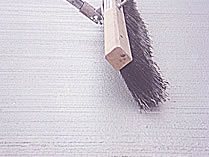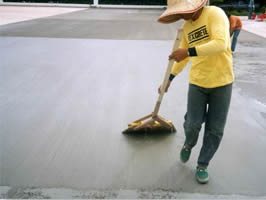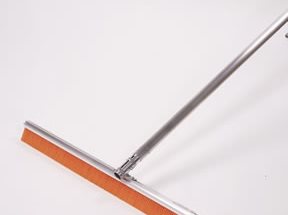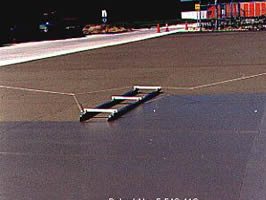Broom Finish Concrete
What is broom finishing and how is it done?Concrete can be finished in many ways. The most basic option is a smooth troweled surface, but this can be slippery when wet. Broom finished concrete solves this problem.
Find concrete contractors near you to help with your project.
WHAT IS BROOM FINISH CONCRETE?
Broom finished concrete is popular for patios, driveways and more. Sometimes called brushed concrete, a broom is used to create a slip-resistant texture on the surface of the concrete. Concrete finishers have been broom finishing for about as long as there has been concrete.

Broom finishes have been used for many years and provide a durable, high-traction surface. Concrete Solutions in San Diego, CA

Broom finished thin overlays add skid resistance and upgrade a deteriorating concrete surface. Concrete Solutions in San Diego, CA.
If you’re considering a broom finish for your concrete, here are the pros and cons:
Pros:
- Slip resistant
- Very affordable
- Easy to do
- Durable
Cons:
- Can be too rough on bare feet
- Not as decorative as other finishes
- May trap dirt and debris
- Can cause color variations
HOW LONG SHOULD YOU WAIT TO BROOM FINISH CONCRETE?
When it comes to brooming, timing is critical—brush too early and the surface will be weak, brush too late and there won’t be enough texture. It must be done while the slab is still soft, but after the bleed water has dissipated. Depending on the weather, this can take anywhere from 20 minutes to 4 hours.
Each contractor has a trick for determining when to broom concrete. Some wait until their finger doesn’t leave an imprint, others simply know it’s ready by how the broom feels when pulled across the surface.
HOW TO BROOM FINISH CONCRETE
The typical process for a broom finish is:
- Pour the slab
- Strike off with a screed
- Bull float
- Wait for the bleed water to evaporate
Although with low water-cement ratio exterior concrete with the proper amount of air, there might not be much bleed water. Bleed water is a result of the wet concrete settling and with entrained air, it doesn't settle much and therefore little water comes to the surface. The proper amount of air is always critical in any exterior concrete that will be exposed to free-thaw action. For concrete with ¾ or 1-inch aggregate, order the concrete with 6% entrained air (plus or minus 1%)-and make sure you are getting it, otherwise the surface will spall. For smaller aggregate you need more air-7% for ½ inch and 7.5% for 3/8 inch. - Trowel
There's some disagreement here. In many cases, today's finishers won't trowel a slab that's getting a broom-finished surface, just bull float and broom. One veteran finisher, however, told me "I like to use a fresno to get the bull float lines out." Bob Simonelli, with Structural Services Inc., says that some troweling is OK, "but be careful not to over-finish the surface and work some of the air out." Advice in a 1996 edition of Concrete Construction's Problem Clinic, however, says you can trowel twice before brooming, but be sure to keep the trowel flat during the second troweling and begin brooming "immediately after the second troweling." If you get the surface troweled hard, it will be difficult to get much texture. PCA's Cement Mason's Guide says to use a damp broom after troweling. - Broom the surface
Run a concrete broom perpendicular to the slope, if there is one. On concrete that's intended to drain, though, broom marks should be run towards the drain. One thing to note is that a broom-finished exterior surface is just as durable as a smooth finish. - Cure the concrete
You can (and must) cure broom-finished concrete with sheets of polyethylene or by spraying on curing compound. For plain gray concrete, a curing agent with some color (typically white) in it helps you to see where it's been applied. The color dissipates after a few weeks. For decorative concrete, use a cure & seal. Don't forget the curing!
A good broom finish is something of an art. Dyes and stains can be applied very successfully to broomed finishes. You can even create decorative effects by running the broom texture in various directions. Typically the broom should be run from side to side of the concrete without stopping. With a standard broom, you should pull the broom towards you, then lift it and set it back on the far side to pull it across again.
WHAT TYPE OF BROOM IS BEST?
Brooms are available from a variety of sources. They come in various widths and the block that holds the bristles can be made from wood, aluminum, or plastic. Brooms tend to be wet a lot and the plastic blocks (high-density polyethylene) won't rot or warp. Bristle materials can be horsehair, polypropylene, or nylon and come in various stiffnesses and sizes to produce different textures. For extreme textures, wire combs are available to produce tined finishes.
Marion Brush makes a brush (the Auto Glide) where the head automatically tilts to the correct angle, so you can get a good broom finish whether you are pushing or pulling the broom.

Concrete brooms come in different configurations,some including brushes that will provide different levels of texture.

Handleless brushes are good for very wide installations. Marion Brush Mfg Co.
Marion Brush Co. specializes in concrete brooms. Their president, Gary Bolden, says that "there are a lot of variables in getting a good broom finish: the slump of the concrete, the weather (sun, wind), and the timing. Every contractor has a tendency to do a slab in their own way. Some might broom sooner than others. Some may pour and broom finish and use a softer brush so they can get on the slab sooner." Marion's Chameleon concrete broom allows you to change out an insert to get different textures or to adjust to conditions. The color-coded inserts come in five textures from supersoft to rough.
Marion's concrete brushes are made from 612 nylon, which Bolden admits is one of the most expensive materials used for brooms, but which he says will outwear other materials by 3 or 4 times. The other advantages of this nylon are that it stays cleaner during use and that it has a memory. No, it can't remember your phone number, but if the bristles get bent, you can pour boiling water on them and they will return to their original shape.
A couple of other interesting kinds of brooms are handleless and brooms attached to bull floats or fresnos. The handleless brooms are pulled back and forth across the surface with ropes-Marion Brush and Cleform make these. This invention is especially handy on very wide pours where it would be difficult to push a broom all the way across and where the bull float handle begins to get so heavy that it pushes the broom too deeply into the concrete. Also available from Marion are brooms attached to bull floats or fresnos. This allows the float to support the weight of the handle rather than the broom. Bolden says that this positions the broom so that the finish is made by the sides of the bristles rather than the tips, which provides a more uniform finish.
SLIP RESISTANT BROOM FINISHED OVERLAYS
Another way to provide slip resistance is to overlay the concrete and broom finish or texture the overlay. There are several products specifically designed for this application. For example, Concrete Solutions' Ultra Surface is a polymer concrete that can go down as thin as 1/16 inch, on a properly prepared surface (typically pressure washed or sandblasted, since the sealers need to be removed). Mapei also makes Concrete Renew, which is similar. These products contain polymers for strength and bonding and should be applied with a squeegee and broom-finished immediately after placement.




